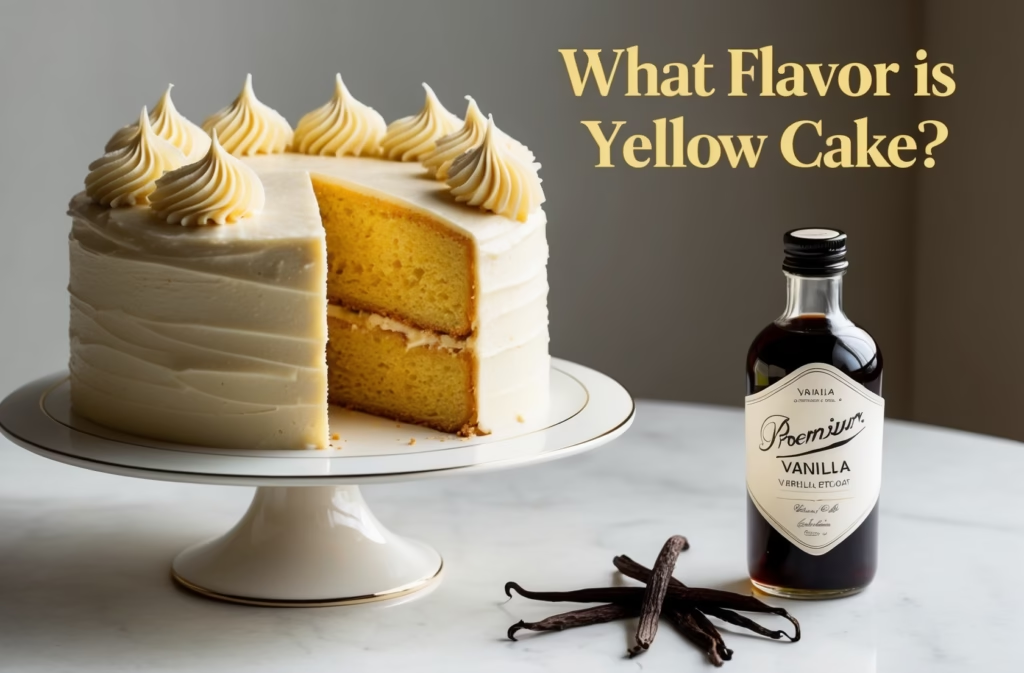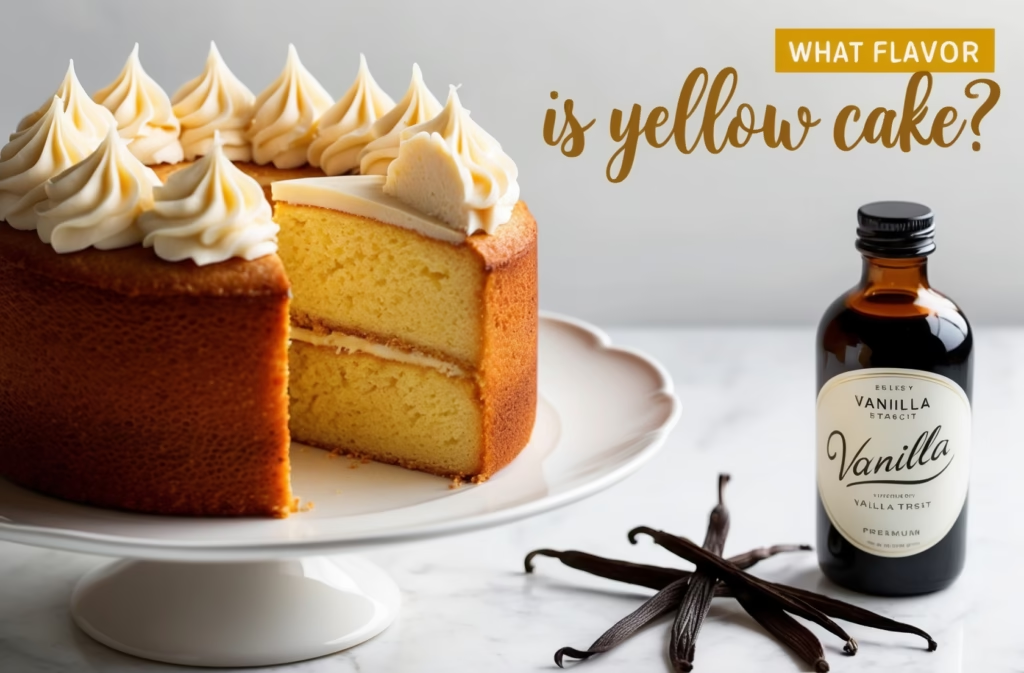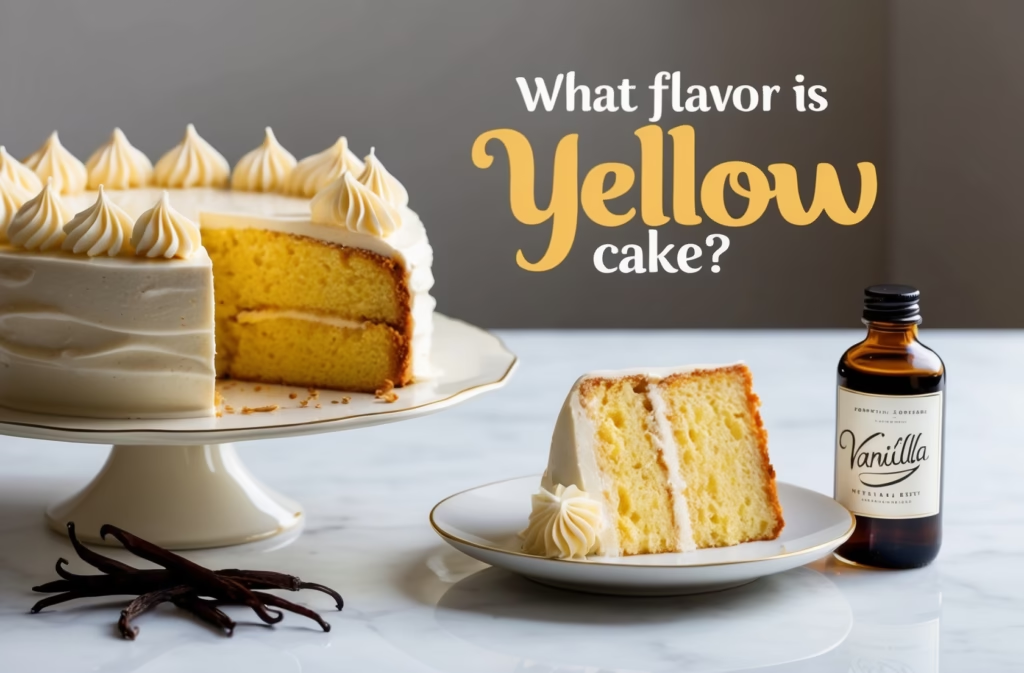What Flavor Is Yellow Cake? Discover the delicious taste of yellow cake & unlock its unique flavor profile. Learn about yellow cake flavor variations and satisfy your culinary curiosity!
What Flavor Is Yellow Cake? Decoding the Deliciousness
The question, What flavor is yellow cake?, seems deceptively simple. After all, it’s just yellow cake, right? But the truth is far more nuanced and delightful. The yellow cake flavor profile is a delightful dance of familiar tastes, subtly influenced by the ingredients and baking process. This article dives deep into the heart of this classic dessert, exploring the components that contribute to its unique and beloved taste of yellow cake.
The Foundation: Butter, Sugar, and Eggs
At the core of every good yellow cake lies a trinity of flavor: butter, sugar, and eggs. The richness of the butter provides a creamy, almost nutty undertone. Granulated sugar offers a sweet base, balancing the other ingredients. And the eggs? They’re the binding agent, contributing both structure and a subtle eggy richness. This foundational trio creates the canvas upon which other flavors can be layered.
The Essence of Vanilla: The Unsung Hero
While often overlooked, vanilla extract plays a crucial role in defining the yellow cake flavor. Its warm, slightly sweet aroma and subtle complexity elevate the cake beyond the simple sweetness of sugar and butter. The quality of vanilla extract used directly impacts the overall taste, with higher-quality extracts delivering a more robust and nuanced flavor profile.
Flour Power: The Structure and Subtlety
All-purpose flour provides the structural integrity of the cake, but it also contributes subtly to the overall taste. The slight nutty flavor of flour blends seamlessly with the other ingredients, creating a harmonious balance. Different types of flour will subtly alter the texture and even the flavor, though all-purpose is the standard for classic yellow cake.
Baking Powder’s Lift: A Light and Airy Touch
Baking powder is the leavening agent, creating the light and airy texture we associate with yellow cake. While not adding direct flavor, its influence on texture is paramount. A properly leavened cake has a delightful tenderness that complements the other flavors beautifully. The lightness of the cake allows the other flavors to shine through, preventing any one taste from overwhelming the others.
Milk’s Moisture: Enhancing the Flavor Profile
Milk adds moisture and richness to the cake, enhancing the overall taste of yellow cake. It helps to create a tender crumb and contributes to a more balanced flavor profile. The type of milk used (whole milk, buttermilk, etc.) can subtly affect the final product, with buttermilk adding a slight tanginess.
Beyond the Basics: Variations on a Theme
While the basic components define the core yellow cake flavor, countless variations exist. Adding citrus zest (like lemon or orange) can brighten the flavor profile, creating a zesty twist on a classic. For a more exotic spin, consider incorporating elements like coconut or spices. Think of the delightful contrast between the richness of a classic yellow cake and the bright tang of a lemon curd cake.
Perhaps you prefer a warm, comforting flavor. The subtle sweetness of maple can elevate your cake to new heights. A maple syrup cake offers a delicious alternative, showcasing the versatility of the base recipe.
For a more adventurous palate, consider experimenting with spices. A ginger-lime cake offers a vibrant fusion of sweet and spicy, while tropical fruits like mango and coconut can create an entirely new dimension of flavor. A mango coconut cake demonstrates the breadth of possibilities.
And for a truly unique experience, consider the intense tang of a passion fruit cake. The bold, tropical notes add a surprising complexity to the familiar foundation of yellow cake.
Understanding the Subtleties of Yellow Cake Flavor
The yellow cake flavor isn’t just one thing; it’s a delicate interplay of various components. The quality of ingredients, baking techniques, and any added flavors all contribute to the final result. A poorly made yellow cake might taste bland or heavy, while a well-made one offers a harmonious blend of sweetness, richness, and subtle complexities. This is why understanding the role of each ingredient is vital for achieving the perfect taste of yellow cake.
Going Beyond the Basic Recipe: Exploring Flavor Combinations
The beauty of yellow cake lies in its adaptability. It serves as an excellent base for a wide range of flavor combinations. Consider pairing your yellow cake with different frostings and fillings to further enhance the flavor profile. A cream cheese frosting offers a tangy contrast, while a chocolate ganache adds a rich, decadent element. The possibilities are endless!
External Resources for Expanding Your Baking Knowledge
For a deeper dive into the science of baking, I recommend checking out resources like the King Arthur Baking website. They offer extensive information on baking techniques and ingredient interactions: King Arthur Baking
Another excellent resource is Serious Eats, which provides detailed articles and recipes from a culinary perspective: Serious Eats
The Verdict: A Deliciously Versatile Flavor
So, what flavor is yellow cake? It’s a combination of sweet, buttery, vanilla-infused deliciousness, subtly enhanced by the other ingredients. Its ultimate flavor profile is a result of the careful balance of each component and, of course, the baker’s skill. It’s a versatile base that can be transformed into countless delightful variations, from the classic to the exotic. The yellow cake flavor is a testament to the simple elegance of well-executed baking.
Share Your Yellow Cake Experiences!
Now it’s your turn! What are your favorite yellow cake flavor variations? What ingredients or techniques do you find contribute most to the delicious taste of yellow cake? Share your experiences and recipes in the comments below – we’d love to hear from you! Let’s continue the conversation about this beloved classic dessert.

Frequently Asked Questions: What Flavor Is Yellow Cake?
- What flavor is yellow cake?
- The yellow cake flavor is primarily a vanilla flavor, often enhanced with a touch of lemon or butter for a richer taste. The color comes from egg yolks and sometimes additional ingredients.
- What is the taste of yellow cake?
- The taste of yellow cake is generally sweet, delicate, and slightly buttery, with a prominent vanilla note. Some recipes add subtle citrus undertones.
- Is yellow cake just vanilla cake?
- While similar, yellow cake flavor isn’t exactly the same as a plain vanilla cake. The egg yolks contribute a richer, denser texture and a slightly different flavor profile.
- What makes yellow cake yellow?
- The yellow color comes from the egg yolks. Some recipes may also include additional ingredients like lemon zest or turmeric to enhance the color and flavor.
- Does yellow cake have a strong flavor?
- No, the yellow cake flavor is typically mild and not overpowering. It’s a versatile base for frostings and fillings.
- What is the difference between yellow cake and white cake?
- The main difference is the color and richness. Yellow cake uses egg yolks, resulting in a richer, denser crumb and a slightly different flavor than white cake, which uses only egg whites.
- Can I add other flavors to yellow cake?
- Absolutely! Yellow cake flavor is easily enhanced with extracts like almond, lemon, or orange, or spices like cinnamon or nutmeg.
- Is yellow cake a popular flavor?
- Yes, yellow cake is a very popular and classic cake flavor, beloved for its versatility and mild, pleasing taste.
- What kind of frosting goes well with yellow cake?
- Many frostings pair well with yellow cake! Cream cheese frosting, buttercream frosting, and chocolate frosting are all popular choices.
- Why is my yellow cake not yellow enough?
- Ensure you’re using enough egg yolks and consider adding a small amount of lemon zest or turmeric for a more vibrant yellow color.

Unlocking the Delicious Mystery: What Flavor Is Yellow Cake?
The question, What flavor is yellow cake? might seem simple, but it opens a delicious door to a world of nuanced flavors and baking secrets. While the name suggests a simple answer, the taste of yellow cake is far more complex and delightful than you might think. This comprehensive guide will not only answer the question but also empower you to bake the perfect yellow cake, understanding the subtle influences that contribute to its signature flavor profile.
The Fundamental Flavors: What Flavor Is Yellow Cake?
At its heart, yellow cake’s flavor is a harmonious blend of buttery richness and subtle sweetness. The key ingredient driving this flavor is, unsurprisingly, the butter. High-quality butter contributes a deep, creamy note that forms the base of the cake’s taste. This buttery foundation is then enhanced by the sweetness of granulated sugar, creating a balance that isn’t overly sugary but provides the perfect level of indulgence. The vanilla extract plays a crucial role, adding a warm, comforting vanilla note that elevates the entire flavor profile.
The all-purpose flour provides a gentle, slightly sweet base, ensuring that the cake maintains its delicate texture while allowing the other flavors to shine. The baking powder is responsible for the light and airy texture, but it doesn’t contribute significantly to the taste. Eggs bind the ingredients together and add richness, but their flavor is largely masked by the other components. Milk adds moisture and a subtle creamy tone, further enhancing the overall mouthfeel and taste.
Variations on a Theme: Exploring Different Yellow Cake Flavors
While the classic yellow cake recipe delivers a beautiful balance of buttery sweetness, the beauty lies in its adaptability. You can easily infuse a variety of flavors into your yellow cake batter to create unique and delicious variations. Imagine the bright citrus notes of a lemon curd cake, the warm, comforting embrace of a maple syrup cake, or the zesty punch of a ginger lime cake. The possibilities are truly endless!
For a tropical twist, consider adding some coconut milk and shredded coconut to achieve a delightful mango coconut cake. Or, for a more exotic flair, explore the tart and sweet complexity of a passion fruit cake. These additions not only enhance the visual appeal but significantly alter the yellow cake flavor, creating a completely new gustatory experience.
Understanding the Science Behind the Yellow Cake Flavor
The Maillard reaction, a chemical reaction between amino acids and reducing sugars, plays a significant role in the flavor development during baking. This reaction creates hundreds of different flavor compounds, contributing to the complex and nuanced taste of the cake. The interaction between the butter, sugar, and flour during the baking process is crucial in achieving that characteristic yellow cake flavor.
According to the King Arthur Baking website, the type and quality of your ingredients significantly impact the final product’s flavor. Using fresh, high-quality ingredients is essential for maximizing the inherent deliciousness of your yellow cake. Similarly, the Food Network provides valuable insights into the science of baking, highlighting the importance of proper mixing techniques and baking times for optimal flavor development.
Recipe: Classic Yellow Cake
This recipe focuses on the fundamental flavors of a classic yellow cake, allowing you to understand the core taste profile before experimenting with variations.
Ingredients:
- 2 1/2 cups all-purpose flour
- 2 1/2 teaspoons baking powder
- 1/2 teaspoon baking soda
- 1/2 teaspoon salt
- 1 cup (2 sticks) unsalted butter, softened
- 1 3/4 cups granulated sugar
- 4 large eggs
- 1 cup buttermilk
- 2 teaspoons vanilla extract
Instructions:
- Preheat oven to 350°F (175°C). Grease and flour two 9-inch round baking pans.
- In a medium bowl, whisk together the flour, baking powder, baking soda, and salt.
- In a large bowl, cream together the butter and sugar until light and fluffy. Beat in the eggs one at a time, then stir in the vanilla.
- In a small bowl, whisk together the buttermilk and add it alternately with the dry ingredients to the wet ingredients, beginning and ending with the dry ingredients. Mix until just combined.
- Divide the batter evenly between the prepared pans.
- Bake for 30-35 minutes, or until a wooden skewer inserted into the center comes out clean.
- Let the cakes cool in the pans for 10 minutes before inverting them onto a wire rack to cool completely.
Nutritional Information (per serving, assuming 12 servings):
| Nutrient Name | Amount per Serving | Daily Value (%) |
|---|---|---|
| Calories | 350 | 17.5 |
| Protein (g) | 4 | 8 |
| Total Fat (g) | 18 | 28 |
| Saturated Fat (g) | 11 | 55 |
| Unsaturated Fat (g) | 7 | N/A |
| Trans Fat (g) | 0 | N/A |
| Cholesterol (mg) | 100 | 33 |
| Total Carbohydrate (g) | 45 | 15 |
| Dietary Fiber (g) | 1 | 4 |
| Total Sugars (g) | 25 | N/A |
| Added Sugars (g) | 25 | N/A |
| Sodium (mg) | 200 | 8 |
| Calcium (mg) | 50 | 5 |
| Iron (mg) | 1 | 6 |
Note: DV percentages are based on a 2,000-calorie diet. These values are estimates and may vary depending on the specific ingredients used.
Summary of Nutritional Features:
This classic yellow cake recipe provides a moderate source of protein and carbohydrates. It’s higher in fat, primarily saturated fat, due to the use of butter. The sugar content is relatively high, primarily from the added sugar. While not a significant source of vitamins and minerals, it does offer some calcium and iron.
What Flavor Is Yellow Cake? Your Turn to Decide!
Now that you’ve explored the multifaceted world of yellow cake flavor, it’s time to get baking! Try out this recipe, experiment with different flavor additions, and share your creations on social media using #YellowCakePerfection and #WhatFlavorIsYellowCake. We’d love to see your baking masterpieces and hear about your experience! Leave a comment below to share your thoughts and any tips you’ve discovered along the way. Happy Baking!

What Flavor Is Yellow Cake?
The flavor of yellow cake is surprisingly diverse, depending on the recipe. While often associated with a simple, vanilla-like sweetness, its true character is far richer and more nuanced. Many recipes rely on the base flavors of butter, eggs, and flour, creating a subtly sweet and buttery foundation. The addition of lemon zest, for instance, can brighten the flavor profile, leading to a lighter, more citrusy experience. If you’re looking for a zesty twist, a delicious alternative could be a lemon curd cake, which infuses the classic yellow cake with a tangy, vibrant lemon flavor.
Other variations can completely transform the yellow cake experience. The addition of spices like cinnamon or nutmeg can introduce warm, comforting notes. For a richer and more complex flavor, you might consider a maple-infused version. The subtle sweetness of maple syrup complements the buttery base beautifully, creating a sophisticated dessert. Check out this amazing maple syrup cake recipe for inspiration!
Beyond the classic additions, adventurous bakers can explore a world of possibilities. Tropical fruits like mango and coconut can introduce bright, exotic notes to the familiar yellow cake. A mango coconut cake brings a taste of the islands to your dessert table.
Alternatively, a unique blend of ginger and lime provides a zesty and slightly spicy twist. The vibrant flavors of ginger and lime beautifully complement the light texture of the cake. For a taste of the unexpected, consider trying this exciting ginger-lime cake.
For something truly unique, consider the intense tropical notes of passion fruit. The tart yet sweet profile of passion fruit creates a captivating flavor contrast against the buttery base of a classic yellow cake. Try this delectable passion fruit cake recipe.
Health Considerations:
While yellow cake can be a delicious treat, it’s important to be mindful of its nutritional content. It’s typically high in sugar, fat, and calories. To make it a healthier option, consider using less sugar and butter, substituting whole wheat flour for some of the all-purpose flour, and adding fruits and nuts for extra fiber and nutrients.
Moderation is key when enjoying yellow cake. It should be treated as an occasional indulgence rather than a regular part of your diet. Pay attention to portion sizes and be mindful of any potential allergies or dietary restrictions before consuming.